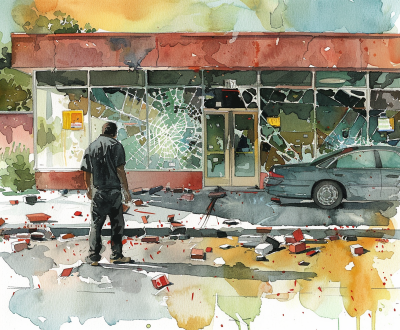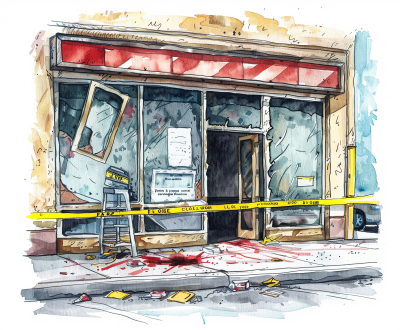Months after election,
is crime still a potent urban issue?
Passed by 68% of voters last November 5, Proposition 36 increased penalties for certain drug offenses and for thefts under $950. On the same day, Nathan Hochman defeated Los Angeles District Attorney George Gascón, 65% to 35%. Gascón was a progressive prosecutor who gave his critics plenty of ammunition to portray him as soft on crime.
The election also saw the defeat of San Francisco Mayor London Breed, 55% to 45%, by Daniel Lurie, an heir to the Levi Strauss fortune, who also promised a crime crackdown. It was a little ironic. After the recall in 2022 of progressive District Attorney Chesa Boudin, 55% to 45%, Breed appointed Brooke Jenkins as DA to reduce crime. Jenkins was retained in a special election that year. Then on Nov. 5, as Breed lost, Jenkins herself was retained by voters, 66% to 44.
But there’s another trend in California of decades’ duration: The passage of criminal justice reforms reducing penalties, followed by reactions that increase penalties. Prop. 36 itself was a reaction to the 2014 passage of Proposition 47, by 60% to 40%, which reduced many crime penalties. Once again, the pendulum has swung in a tough-on-crime direction.
With so much action last November, are any trends evident five months later? “As expected, implementation varies across counties and across jurisdictions,” Magnus Lofstrom told me; he’s policy director and senior fellow at the Public Policy Institute of California. “The reform was designed for locals to use their own discretion in how to enforce the proposition.”


He pointed to an April 9 blog post of his listing some of the latest statistics, “Crime in California Is Trending Downward, New Data Suggests.” But the numbers are for 2024, not the months since the election. Also, the numbers are preliminary and derive data from 29 California law-enforcement agencies, covering one-quarter of the state’s population. He said a strong trend downward began in late 2023, “and that’s encouraging news.”
The change also in part derives from getting past the crime spike that hit during the 2020-21 COVID-19 pandemic, which saw cooped-up Americans rage against the lockdown machine. And that period coincided with another pandemic—that of fentanyl overdose deaths, now subsiding.
The basic trends from his post: “Aggravated assaults and robberies decreased by about 4% and 5% respectively. For the first year since 2020 auto theft fell, by roughly 12%. Compared to 2019, property crime was 11% lower but violent crime was higher, by about 6%.” Lofstrom explained the data are from “a new and reputable source, the Real Time Crime Index,” which collects monthly data. Official government data for the full year will be available this summer.
To that add a San Francisco Chronicle story, also from April 9 and based on the RTCI, showing the City by the Bay enjoyed an even larger improvement: “[V]iolent crime fell by 14%. The difference in property crime trends [was] even more extreme: the mid-sized cities saw a 9% decrease in aggregate, while San Francisco saw a 28% decrease.”
The positive crime data from 2024 present an obvious problem: How to distinguish 2025 crime drops, if any, from the preexisting trend of crime going down.
Although we can’t see the full effects of the changes, there will be early indications, Lofstrom said. As arrests from Hochman’s crackdown go up, a problem will be Los Angeles’ already limited jail space. “Currently, county jails house over 14,000 inmates in facilities designed for 12,428, creating severe strains on resources and prompting high-profile lawsuits, including one from the American Civil Liberties Union (ACLU), which cited inhumane conditions and inadequate mental health services,” Westside Current reported last November.
Perhaps a bigger problem comes from the federal immigration crackdown. “Trust is challenged in the immigrant communities in reporting crime,” Lofstrom said. “That means we may hear of fewer crimes that are being committed. But that policy is even newer than the Prop. 36 implementation.” That point was reinforced by a January 31 report in The Orange County Register headlined, “Heightened deportation fears could lead to underreporting crimes, less cooperation with police, scholars say.”
Has the crime data or election results changed politicians’ behavior? The answer is as inconclusive as the data itself.
The April 11 Center Square reported the Democratic-controlled Legislature shunned a proposal by Republicans for $400 million in funding for drug felonies mandating treatment under Prop. 36. Most members of the Democratic majority, as well as Gov. Gavin Newsom, opposed the measure. The Republican super-minority in the Legislature pointed futilely to a letter by the governor celebrating Crime Victims’ Rights Week, April 6-12, in which he called for “support for victims, survivors, and their families and to recognize their right to be supported, heard, and treated with fairness, dignity and respect.”
To no avail. Gov. Gavin Newsom’s did not put funding in his January 10 budget proposal for fiscal year 2025-26, which begins on July 1. He also left such funding out of his May budget revision, which suggests a return by Democrats to their lackadaisical ways about public safety.
But then Republicans showed that crime can still be a potent political issue. In early May, they embarrassed Democrats into imposing “harsher penalties for soliciting sex from 16- and 17-year-olds,” CalMatters reported. “The fight laid bare the splinters among Democrats and forced Assembly leaders into damage control mode. The end result? An overwhelming Assembly vote on Thursday to raise penalties for teen sex solicitation, with no votes in opposition.”
Keep an eye out on forthcoming data, as crime remains one of the few issues that poses challenges for the state’s Democrats—and something that can clearly motivate voters at the state and local level.
John Seiler is on the Editorial Board of the Southern California News Group.
